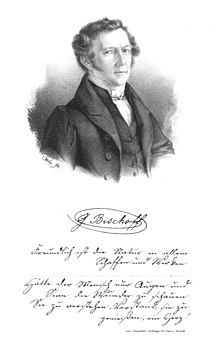Gottlieb Wilhelm Bischoff

Gottlieb Wilhelm Bischoff (21 May 1797 – 11 September 1854) was a German botanist and university professor. He was among the first to examine the reproduction of mosses and liverworts and is credited with coining the terms archegonia and antheridia.
Bischoff was born in Dürkheim and studied botany under Wilhelm Daniel Koch, the author a major flora of Germany, in Kaiserslautern. He then went to the Academy of Fine Arts, Munich in 1819 and then studied botany in Erlangen from 1821. He began to teach in Heidelberg from 1824 and received a habilitation in 1825. He became a professor of botany in 1833 and directed the botanical garden in Heidelberg from 1839. He specialized in the liverworts and mosses coining the terms archegonium and antheridium.[1] Bischoff issued the exsiccata Herbarium normale plantarum officinalium et mercatorium.[2]
The genus Bischofia was named after Gottlieb Wilhelm Bischoff by Karl Blume.[3]
The standard author abbreviation Bisch. is used to indicate this person as the author when citing a botanical name.[4]
References
- ^ Ziegenspeck, Hermann (1955). "Bischoff, Gottlieb Wilhelm". Deutsche Biographie (in German). Vol. 2. Berlin: Duncker & Humblot. p. 263.
- ^ "Herbarium normale plantarum officinalium et mercatorium: IndExs ExsiccataID=537087872". IndExs – Index of Exsiccatae. Botanische Staatssammlung München. Retrieved 13 July 2024.
- ^ Quattrocchi, Umberto (2016). CRC World Dictionary of Medicinal and Poisonous Plants: Common Names, Scientific Names, Eponyms, Synonyms, and Etymology. CRC Press. p. 992.
- ^ International Plant Names Index. Bisch.
External links
- Lehrbuch der botanik (1834)
- CS1 German-language sources (de)
- Articles with short description
- Short description is different from Wikidata
- Botanists with author abbreviations
- Articles with ISNI identifiers
- Articles with VIAF identifiers
- Articles with WorldCat Entities identifiers
- Articles with BNF identifiers
- Articles with BNFdata identifiers
- Articles with GND identifiers
- Articles with J9U identifiers
- Articles with LCCN identifiers
- Articles with NKC identifiers
- Articles with NLG identifiers
- Articles with NTA identifiers
- Articles with PLWABN identifiers
- Articles with VcBA identifiers
- Articles with Botanist identifiers
- Articles with Leopoldina identifiers
- Articles with DSI identifiers
- Articles with DTBIO identifiers
- Articles with SUDOC identifiers
- Articles with TePapa identifiers
- 19th-century German botanists
- 1797 births
- 1854 deaths
- People from Bad Dürkheim